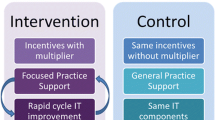Abstract
The US spends significantly more money as a percentage of GDP on health care than any other OECD country and more importantly, this amount is anticipated to increase exponentially. In this high cost environment, two important trends have occurred: (1) the movement to managed care, and (2) large investments in Information Systems/Information Technology (IS/IT). Managed care has emerged as an attempt to provide good quality yet cost effective health care treatment. Its implications are not well discussed in the literature while, its impact on different types of medical group practices is even less well understood. The repercussions of the large investments in IS/IT on the health care sector in general and on the medical group practice in particular, although clearly of importance, are also largely ignored by the literature. This study attempts to address this significant void in the literature. By analyzing three different types of group practices; an Independent Practice Association (IPA), a Faculty Practice and a Multi Specialty Group Practice in a managed care environment during their implementation of practice management/billing systems, we are able to draw some conclusions regarding the impacts of these two central trends on health care in general as well as on the medical group practice in particular.
Similar content being viewed by others
References
L. Applegate, F. McFarlan and J. McKenney, Corporate Information Systems Management: Texts and Cases (Irwin, Boston, 1996).
W. Knight, Managed Care: What It Is and How It Works (Aspen Publication, MD, 1998).
N. Wickramasinghe, IS/IT as a tool to achieve goal alignment in the health care industry, Int. J. Healthcare Technology and Management 2(1–4) (2000) 163–180.
Committee on Quality of Health Care in America Institute of Medicine, Crossing the Quality Chasm – A New Health System for the 21st Century (National Academy Press, Washington, DC).
G. Huber, A theory of the effects of advanced information technologies on organisational design, intelligence, and decision making, Academy of Management Review 15(1) (1990) 47–71.
L. Applegate, R. Mason and D. Thorpe, Design of a management support system for hospital strategic planning, Journal of Medical Systems 10(1) (1986) 79–94.
R. Chandra, M. Knickrehm and A. Miller, Health care's IT mistake, The McKinsey Quarterly 5 (1995).
L. Wolper, Health Care Administration (Aspen Publication, MD, 1995).
P. Kongstvedt, The Managed Health Care Handbook (Aspen Publication, MD, 1993).
P. Kongstvedt, The Managed Health Care Handbook (Aspen Publication, MD, 1997).
A. Enthoven, The history and principles of managed competition, Health Affairs (1993) 25–48.
A. Hillman, Financial incentives for physicians in HMOs, New England Journal of Medicine 317(27) (1987) 1743–1748.
P. Starr, The Social Transformation of American Medicine (Basic Books, 1982).
C. Kane and K. Duke, Ready set wait! Hospitals and Health Networks 70(12) (1996) 51.
P. Jacobs, E. Hall and T. Noseworthy, Management control systems for hospital clinical services, CMA Magazine 1(1) (1994) 19–22.
A. Alchian and H. Demsetz, Production, information costs and economic organisations, American Economic Journal Review 62(5) (1972) 777–795.
M. Jensen and W. Meckling, Theory of the firm: Managerial behavior, agency costs and ownership structure, Journal of Financial Economics 3 (1973) 305–360.
S. Ross, The economic theory of agency: The principal's problem, American Journal of Economic Review 2 (1973) 134–139.
R. Wilson, The theory of syndicates, Econometerica 36 (1968) 119–132.
M. Jensen and W. Meckling, Specific and general knowledge, and organizational structure, in: Contract Economics, eds. L. Werin and H. Wijkander (Blackwell, 1992) pp. 251–291.
P. Drucker, Post-Capitalist Society (Harper Collins, New York, 1993).
R. Kelly, Managing the new workforce, Machine Design 62(9) (1990) 109–113.
S. Nonaka and N. Takeuchi, The Knowledge Creating Company (Oxford University Press, New York, 1995).
M. Wheeler, Perfect knowledge: The physician's role, Health Management Technology 16(4) (1995) 26–30.
R. Simons, Levers of Control (Harvard Business School Press, Boston, 1995).
P. Keen, Shaping the Future Business Design through Information Technology (Harvard Business School Press, Boston, 1991). 86 N. WICKRAMASINGHE, J.B. SILVERS
M.S. Morton, The Corporation of the 1990s (Oxford University Press, New York, 1991).
N. Wickramasinghe, IS/IT as a tool to achieve goal alignment in the context of the knowledge worker in the health care industry, Ph.D. dissertation, Case Western Reserve University (1999).
K. Eisenhardt, Building theories from case study research, Academy of Management Review 14 (1989) 532–550.
R. Boyatzis, Transforming Qualitative Information Thematic Analysis and Code Development (Sage, Thousand Oaks, CA, 1998).
S. Kavale, Interviews an Introduction to Qualitative Research Interviewing (Sage, Thousand Oaks, CA, 1996).
R. Wigand, A. Picot and R. Reichwald, Information, Organisation and Management (Wiley, Chichester, 1997).
M. Ruef and W.R. Scott, A multidimensional model of organizational legitimacy: Hospital survival in changing institutional environments, Administrative Science Quarterly 43 (1998) 877–904.
R. Yin, Case Study Research: Design and Methods, 2nd Ed. (Sage, Newbury Park, 1994).
Author information
Authors and Affiliations
Rights and permissions
About this article
Cite this article
Wickramasinghe, N., Silvers, J. IS/IT the Prescription to Enable Medical Group Practices Attain Their Goals. Health Care Management Science 6, 75–86 (2003). https://doi.org/10.1023/A:1023376801767
Issue Date:
DOI: https://doi.org/10.1023/A:1023376801767




